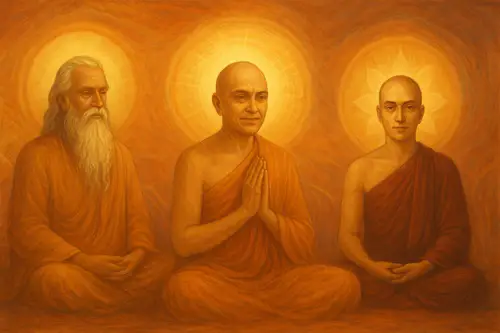|
TRANSLATE THIS ARTICLE
Integral World: Exploring Theories of Everything
An independent forum for a critical discussion of the integral philosophy of Ken Wilber
  Frank Visser, graduated as a psychologist of culture and religion, founded IntegralWorld in 1997. He worked as production manager for various publishing houses and as service manager for various internet companies and lives in Amsterdam. Books: Ken Wilber: Thought as Passion (SUNY, 2003), and The Corona Conspiracy: Combatting Disinformation about the Coronavirus (Kindle, 2020). Frank Visser, graduated as a psychologist of culture and religion, founded IntegralWorld in 1997. He worked as production manager for various publishing houses and as service manager for various internet companies and lives in Amsterdam. Books: Ken Wilber: Thought as Passion (SUNY, 2003), and The Corona Conspiracy: Combatting Disinformation about the Coronavirus (Kindle, 2020).
Check out my other conversations with ChatGPT
THOUGHTS ON ADI DA SAMRAJ
The Legacy of Adi Da Samraj The Myth of Uniqueness Two Models of Inner Transformation Beyond Lineage, Beyond Comparison Narrative Control in Adi Da's Writings Beyond Lineage, Beyond ComparisonAdi Da's Transmission NarrativeFrank Visser / ChatGPT

1. Introduction: Legitimacy and TranscendenceModern gurus operating in the post-1960s West have faced a double challenge: on the one hand they must demonstrate continuity with venerable Eastern traditions, and on the other they must stand out as unique, epochal figures. Adi Da Samraj (born Franklin Jones) provides an especially clear example. While he explicitly linked himself to the celebrated Siddha Yoga lineage of Nityananda-Muktananda, he also declared himself an unprecedented, world-transforming Avatar whose realization exceeded all historical precedents. This essay examines how Adi Da's “lineage-but-beyond-lineage” claim worked and why it appealed to seekers — and what its pitfalls reveal about the modern guru phenomenon. 2. The Lineage: Nityananda → Muktananda → Adi DaWhen Jones traveled to India in 1968, Swami Muktananda initiated him through shaktipat (the transmission of kundalini energy). Muktananda himself had been the chief disciple of Bhagavan Nityananda, the archetypal siddha of modern Maharashtra. Thus, by the ordinary logic of Indian guru-disciple relations, Jones became part of this lineage. Early photos of him with Muktananda were circulated among his first followers, and he frequently cited both men in his initial books. 3. The Pivot: “Already Realized”Even as he acknowledged Muktananda's catalytic role, Adi Da soon claimed that his awakening had already occurred in childhood as “the Bright” and that his 1970 “Re-Awakening” was simply the final confirmation of his birthright. Muktananda, in this telling, merely recognized what was already true. This rhetorical pivot allowed Adi Da to use lineage for legitimacy while decoupling his own authority from any prior figure. 4. Legitimacy through LineageAligning with a recognized tradition confers legitimacy in three ways:
For a young American guru in the early 1970s, these were essential building blocks. 5. Transcendence beyond LineageOnce a baseline of credibility is achieved, many modern gurus claim transcendence:
This combination legitimizes their teaching but frees them from oversight, institutional checks, or the norms of the tradition. 6. The Appeal to Western SeekersFor disillusioned Westerners, this “lineage plus transcendence” narrative offered both the exotic and the new:
This blend helped Adi Da stand out among the crowded field of 1970s gurus. 7. The Risk of Inflated ClaimsThe same dynamic that lends authority also shields the teacher from criticism. By claiming to stand beyond comparison, Adi Da could frame any critique as misunderstanding, ego-resistance, or spiritual immaturity. This creates a closed epistemic loop: the more unique the teacher claims to be, the less falsifiable their claims become. 8. Contrast with Wilber's EndorsementKen Wilber's early praise of Adi Da exemplified the allure of this strategy. Wilber openly called him “the greatest living Realizer” while also portraying him as the apex of a developmental spectrum of saints and sages. Yet this endorsement itself mirrored Adi Da's narrative: rooted in history, but culminating in him. 9. Lessons from the “Lineage-but-Beyond” Strategy
Sidebar: Other Gurus Who Claimed Lineage—and Transcendence
Pattern:
10. Conclusion: The Double-Edged Sword of TransmissionAdi Da's relationship with the Nityananda-Muktananda lineage exemplifies a broader phenomenon: modern gurus' skill at using lineage to gain legitimacy, then discarding its constraints to assert unprecedented status. This strategy resonates with seekers but leaves them vulnerable to inflated promises. In a post-guru age, discerning students and scholars alike must ask: what remains when the mystique of transmission is stripped away, and how do we evaluate claims of enlightenment without either blind faith or automatic cynicism?
Comment Form is loading comments...
|